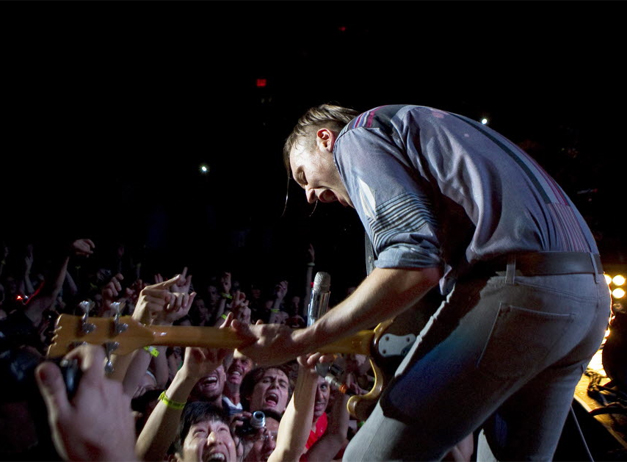Arcade Fire has come a long way since it was formed 10 years ago. Here are the milestones in the band’s journey from obscurity to international stardom.

2001
Arcade Fire begins performing in lofts and art galleries in and around the Montreal area. At the time the band consists of Win Butler, Regine Chassagne, Myles Broscoe, Dane Mills and Brendan Reed
2002
Broscoe leaves the band due to tension with Butler. Richard Reed Parry joins the band.
2003
The band releases its self-titled EP. Butler and Reed argue in the middle of a show and Reed quits on the spot. William Butler and Tim Kingsbury replace Reed and Mills.
The band signs a record deal with the independent label, Merge Records.
2004
The album “Funeral” is released in Canada in September, and in the U.K. five months later. The album is well-received critically and commercially, and appears on many top ten album lists.
2005
The MTV2 Review names “Funeral” the best album of the year. By November, the album has gone gold in Canada and the U.K., and sold over half a million copies worldwide.
The band continues a tour that had started the year before, moving into bigger venues in Canada, the U.S., Europe and even Japan.
Arcade Fire is featured on the April 4, 2005 cover Time magazine’s Canadian edition.
A month later, the band signs a short-term publishing contract with EMI for “Funeral.”
In September, the band appears on a television special with David Bowie. Their joint recordings are made available on iTunes in a virtual live EP.
The band makes several high-profile television appearances.
The song “Wake Up” is played before U2 opened their concerts on the 2005-2006 Vertigo tour. Arcade Fire then opens three shows on that tour.
2006
Funeral and the single “Cold Wind” are nominated for Grammys in the “best alternative rock album” category and “best song written for a motion picture or other visual media.”
In April, the band receives a Juno Award for “songwriters of the year.” The band is also nominated for three BRIT Awards.
Intervention is the first track released from their new album, “Neon Bible.” The album promptly climbs the charts, and gains critical acclaim.
2007
In February, the band makes its first appearance on Saturday Night Live.
The Neon Bible Tour continues into November, with more than 25 dates scheduled for North America and Europe.
2008
Arcade Fire performs two four concerts for U.S. Presidential candidate Barack Obama.
The band releases the concert film, “Miroir Noir,” which includes live footage from the Neon Bible Tour.
2010
In the summer, the band releases the album, “The Suburbs.” It’s released with eight different covers. The album is a critical and commercial success.
In August, Arcade Fire and Google release an interactive music video which utilizes the band’s song, “We Used to Wait.”
In November, Arcade Fire makes its second appearance on Saturday Night Live, performing “We Used to Wait” and “Sprawl II (Mountains Beyond Mountains)”.
2011
Arcade Fire appears in the Grammy Awards on Feb. 13th and wins the “album of the year” award for “The Suburbs.”
Two days later, the ban wins two prizes at the Brit Awards — “best international album” and “best international group.”
In September, Arcade Fire wins the $30,000 Polaris Music Prize, for “The Suburbs.”
In December, the group’s
deluxe CD/DVD re-release of last year’s album of the year winner “The Suburbs”
has been nominated for another Grammy Award for best recording package.
The band
isn’t technically named in the nomination, which went instead to Montrealer
Vincent Morisset, who served as art director on the project.
The package
included the original “Suburbs” disc with two bonus tracks, a 30-minute short
film inspired by the album entitled “Scenes from the Suburbs” and an
80-page booklet with stills from the film and behind-the-scenes
photographs.






Comments